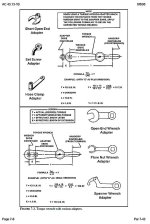So I received my new issue of KitPlane magazine and was reading a tip about modifying a tool for accessing tight areas (I think it was written by our own Larry Larson)
In the article he admonishes us to do the math for the additional length of the wrench.
I used to know this stuff in a previous life but I have forgotten the math and haven't had much luck with my searches.
Soooo... The question is:
How does one do the math for an extended torque wrench (crows foot for instance)?
And even more mystifying.
How to we compensate for the locking fasteners?
ie. I set the torque wrench to the proper value and it clicks before the nut is fully bottomed out.
When I was wrenching on certified iron, I don't remember using many locking nuts for critical items...everything was safetied.
In the article he admonishes us to do the math for the additional length of the wrench.
I used to know this stuff in a previous life but I have forgotten the math and haven't had much luck with my searches.
Soooo... The question is:
How does one do the math for an extended torque wrench (crows foot for instance)?
And even more mystifying.
How to we compensate for the locking fasteners?
ie. I set the torque wrench to the proper value and it clicks before the nut is fully bottomed out.
When I was wrenching on certified iron, I don't remember using many locking nuts for critical items...everything was safetied.





